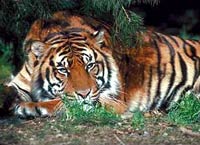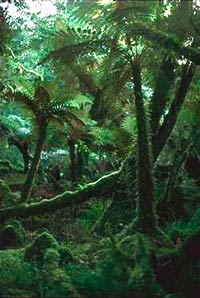Throughout its more than 40 years, WWF has contributed significantly to the development and impact of the world conservation movement and to sustainable development. Here are a few examples of the impressive work WWF has done:
 2008 HowStuffWorksProject Toger worked to protect the tiger population.
2008 HowStuffWorksProject Toger worked to protect the tiger population. - Launched in 1973, WWF set up a task force with Indira Gandhi to put aside land for nine
tiger reserves in India. India later added six more reserves, while Nepal followed suit with three, and Bangladesh with one. Today, there are 23 tiger reserves in India spread over an area of about 33,000 square kilometers (12,700 square miles). Outside of India, WWF is working to protect Sumatran tigers in Indonesia, Indo-Chinese tigers in Malaysia, Bengal tigers in Nepal, and Siberian tigers in Russia. To find out more about Project Tiger and other global tiger concerns, check out these sites:
 2008 HowStuffWorksThe WWF has actively worked to save rainforest habitats around the world.
2008 HowStuffWorksThe WWF has actively worked to save rainforest habitats around the world. - Launched in 1975, WWF raised money and arranged for several dozen representative
tropical rainforest areas in Central and West Africa, Southeast Asia, and Latin America to be managed as national parks or reserves. A second tropical forest campaign was launched in 1982 at the opening of the national parks congress in Bali (Indonesia), which mobilized roughly $2.5 million for projects in 11 countries. Forest conservation has been taken seriously as a major habitat issue ever since. For more on tropical rainforests, check out these sites:
The Seas Must Live - Launched in 1976, WWF set up marine sanctuaries for whales, dolphins, and seals, and to protect marine turtle nesting sites. Currently, WWF is working around the world to save our seas and marine life by building up political will to end chronic overfishing, reducing the use of destructive fishing methods, rebuilding devastated fisheries, and improving resource management. For more information on this important issue, click here:
Save the Rhino - Launched in 1979, WWF raised over $1 million to combat rhino poaching. Thanks to the efforts of WWF, the number of rhinoceroses in Kaziranga National Park, India, rose from 400 in 1966 to 1,300 in 1995; in Chitwan Park, Nepal, from 60 in the late 1960s to 600 today; and in southern Africa, from 20 at the turn of the last century to nearly 8,000 today. For more on rhinos, check out:
World Conservation Strategy - In 1980, WWF published a recommended set of strategies that suggest taking a holistic approach and highlight the importance of using natural resources in a sustainable fashion. The strategy defined the three chief goals of conservation: maintenance of essential ecological processes and life support systems; preservation of genetic diversity; and sustainable use of species and ecosystems. Since the launch, 50 countries have formulated and initiated their own conservation strategies based on WWF's recommendations. Click here to found out how you can obtain a copy of WWF's strategy series.



